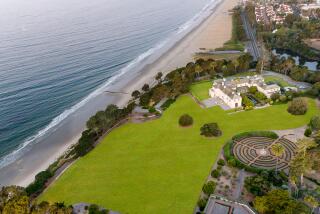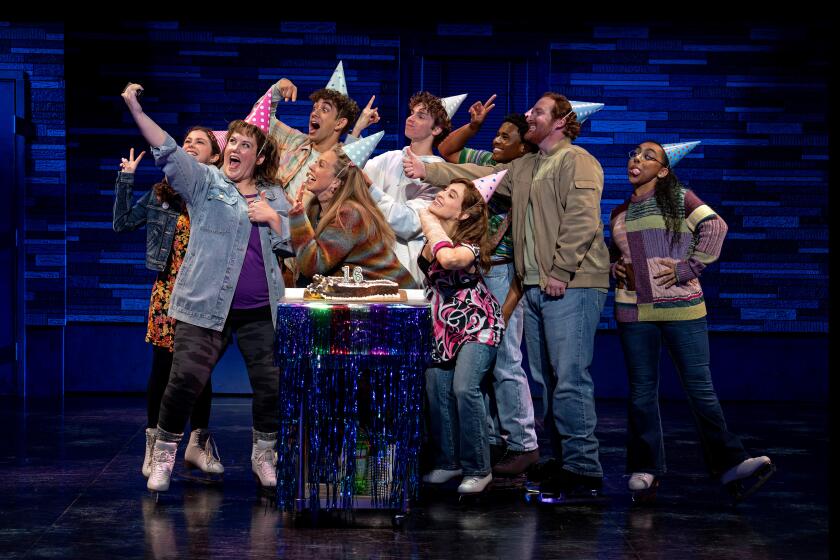‘Lost and Found’ of Buildings
Times are tough for historic preservationists. On Tuesday, Coronado’s City Council voted 3-1 to demolish the beautiful circa-1922 Babcock Court apartments to make way for a police station. And today, the San Diego City Council, in a budget-slashing meeting, will consider eliminating its historic preservation staff.
If there was ever a good time for some serious consciousness-raising on historic preservation, it’s now. “San Diego Lost & Found,” a show at the Mesa College Art Gallery and the Athenaeum Music & Arts Library in La Jolla, probably won’t cause many important decision-makers to change their minds. Most likely, few will pay a visit. But, if the show raises preservation awareness in San Diego even a little bit, it will have done its work.
The exhibit takes an in-depth look at 13 historically significant projects. The bulk of the materials are at Mesa College, where 10 of the projects are included in an exhibit that opens Friday, organized by Catherine Whalen, a museum studies student at Mesa.
Three La Jolla structures--the Green Dragon Colony bungalows, architect R. M. Schindler’s El Pueblo Ribera apartments and the Athenaeum building--are subjects of the Athenaeum portion of the show, which opens Oct. 13 and was assembled by Mesa museum studies students Daniel Foster and Anne Garrison.
*
Whalen is an experienced interior designer who formerly worked for a New York architectural office and is now employed as a curatorial assistant at the Escondido Center for the Arts. Her painstaking research makes the Mesa portion of the show incredibly powerful and informative. Those who have any respect for the value of historic buildings in preserving a city’s essential character won’t leave with dry eyes.
Especially moving are large photographs of vital buildings already lost to the wrecking ball, including the original Victorian-era Santa Fe Depot downtown, the Aztec Brewery in Barrio Logan and the Mission Beach Plunge, which was torn down and re-created in superficial fashion as part of the Belmont Park redevelopment completed in 1988.
The Klauber house (Whalen gives a date of 1909, others argue that it was completed in 1907), designed by Irving Gill, produces the most gut-wrenching impact.
*
Considered by experts to be one of Gill’s most important residential designs, the large two-story home at 6th Avenue and Redwood Street featured crisp white stucco walls, intimate relationships between indoor and outdoor spaces and a tile roof with an Oriental flair at the eaves. The house showed Gill in a transitional phase between an early, rustic Craftsman style and his trademark stripped down modernism.
After preservationists lost several court battles, the Klauber house was torn down in 1979. The lot stood vacant for 10 years before a 10-story condominium complex was built.
But the exhibit is much more than a moving testimonial in pictures.
Whalen chose her case study projects from demolished, saved and still-endangered structures. Then she thoroughly documented the history of each to illustrate their historic merits, and the difficult, complex processes faced by any preservation efforts.
Through Whalen’s texts, included in a catalogue for the show, visitors can relive the agonizing weeks and months of work that went into saving, or attempting to save, endangered buildings.
The vivid picture that emerges is of a city government, and sometimes citizens, who have little regard for historic buildings and the vital contribution they make to a city’s identity.
Taken as individual cases, the failed preservation efforts documented by Whalen are sad stories. As a group, they are overwhelming. It is hard to believe that one city could allow so many fine structures to perish, despite the concerted efforts of preservationists.
Whalen tells of the long, unsuccessful battle to save the Aztec Brewery, a brick building designed in 1911 by the Quayle Brothers, that originally was home to the Savage Tire Factory. During the 1930s, Spanish artist Jose Moya de Pino added interior wall murals depicting Aztec culture.
The San Diego City Council pushed for development. Courts and some community members agreed, and the building was torn down in May, 1990, although the murals were saved--some are now displayed in Chuey’s restaurant in Barrio Logan.
Another black mark goes to the city for its handling of Belmont Park. Despite the signatures of 80,000 San Diegans who favored saving the original circa-1925 buildings, and against the advice of its own Historical Site Board, the city allowed the old buildings, including the Plunge and a roller rink, to be torn down in 1987. Later that year, San Diego voters passed Prop. G, which rejected the use of public parkland for commercial development, but the vote came too late to help Belmont Park.
On a positive note are several success stories Whalen has included, and the possibility of saving endangered structures covered by the displays at both Mesa and the Athenaeum, including Schindler’s El Pueblo Ribera and the El Cortez Hotel and Balboa Theatres in downtown San Diego (as Whalen notes, the California and North Park theaters in San Diego are also threatened, and the Lyceum and Orpheum are long gone).
Among the preservation stories with positive endings, few could be considered complete successes.
The main portion of the circa-1915 Mission Revival-style Santa Fe Depot downtown, designed by Bakewell & Brown, has been preserved, but an arcaded forecourt that was part of the original structure was converted into a parking lot in 1954.
The circa-1927 Chinese Mission building downtown, part of a Chinese Historic District designated by San Diego in 1987, was subsequently moved from its original site at 1st Avenue and G Street to a vacant city lot downtown, where it still languishes in unusable condition. Meanwhile, developer Charles Tyson’s high-rise development proposal for the original Mission site is stagnant, a casualty of the real estate recession.
In 1989, the Historical Site Board designated an Egyptian Revival historic district on Park Avenue that would have included the circa-1926 Egyptian Court Apartments, a rare San Diego example of Egyptian Revival. But the San Diego City Council voted the district down.
In 1988, the owner of the apartments jackhammered away much of their elaborate Egyptian ornamentation. Luckily, current owner Jim Nicholas restored the decoration in 1991.
Even more disconcerting than lackadaisical San Diego attitudes toward preservation is the fact that, for each of the projects documented by Whalen, there are 10 of other important San Diego buildings already lost or still endangered.
Among these are the Babcock Court in Coronado and several demolished Gill buildings, including the 1915 Ellen Browning Scripps residence in La Jolla on the site now occupied by the San Diego Museum of Contemporary Art, the 1911 Timken house at 4th Avenue and Walnut Street and the Children’s Home Assn. buildings near Balboa Park, designed by Gill and Hazel Waterman, demolished during the 1960s during construction of Interstate 5.
Still other preservation losses include the Knickerbocker Hotel next to the Balboa Theater downtown and designed by Eugene Hoffman, torn down to make way for Horton Plaza, and several 1930s Deco-era buildings downtown, including the Tower Theatre and Tower Bowl, both designed by S. Charles Lee.
The way things are going this week--make that this century--preservation fires in San Diego are burning low, but at least Whalen and her peers are keeping the flame lit.
* At Mesa College, “San Diego Lost & Found” runs Friday through Nov. 11, while the Athenaeum portion of the show, opening Tuesday, will close Nov. 21.
Accompanying the exhibits are a lecture by Bruce Kamerling, a San Diego expert on historic preservation, at 9:30 a.m., Oct. 24, at the Wednesday Club, 6th Avenue and Ivy Lane, followed by a tour of historic homes; a talk by Frank Lloyd Wright’s grandson, Eric, an architect, on Oct. 29 at Sherwood Auditorium in La Jolla; and a lecture on historic preservation by architect Jeffrey Shorn and Charlies Kaminski at the Athenaeum on Nov. 8 at 4 p.m., followed by a buffet and a panel discussion featuring Shorn, San Diego city architect Mike Stepner, attorney Marie Lia and Save Our Heritage Organization board member David Swarens. For more information on the exhibits or related events, call the Mesa College Art Gallery at 627-2878, or the Athenaeum Music & Arts Library at 454-5872.
More to Read
The biggest entertainment stories
Get our big stories about Hollywood, film, television, music, arts, culture and more right in your inbox as soon as they publish.
You may occasionally receive promotional content from the Los Angeles Times.










